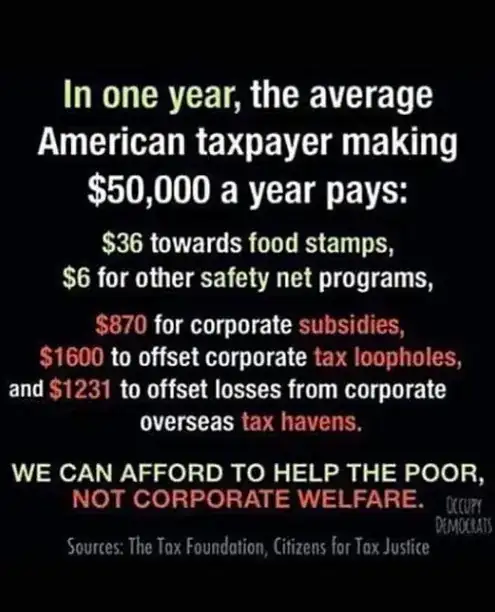The last three numbers seem to be based on the same data as this Common Dreams article:
$870 for Corporate Tax Subsidies
We've heard a lot about tax avoidance and tax breaks for the super-rich. With regard to corporations alone, the Tax Foundation has concluded that their "special tax provisions" cost taxpayers over $100 billion per year, or $870 per family. Corporate benefits include items such as Graduated Corporate Income, Inventory Property Sales, Research and Experimentation Tax Credit, Accelerated Depreciation, and Deferred taxes.
Once again, it may be even worse. Citizens for Tax Justice cite a Government Accountability Office report that calculated a loss to the Treasury of $181 billion from corporate tax expenditures. That would be almost $1,600 per family.
$1,231 for Revenue Losses from Corporate Tax Havens
U.S. PIRG recently reported that the average 2012 taxpayer paid an extra $1,026 in taxes to make up for the revenue lost from offshore tax havens by corporations and wealthy individuals. With 138 million taxpayers (1.2 per household), that comes to $1,231 per household.
Note that this double counts corporate tax subsidies as corporate subsidies and tax loopholes based on the figures from two different sources. It should be either $870 or $1600, not both.
That source doesn't use a $50,000 family. The values are calculated by dividing the total cost by the number of households.
It's also questionable whether the average taxpayer "pays" taxes to offset any of this. The federal government external deficit in 2012 was over $1 trillion. Even if they could somehow collect this amount of money, it still wouldn't have offset the deficit that year.
I didn't find a real reference for the food stamp numbers. Here is a forum post that seems to link to an article. But the article is gone and does not appear on archive.org. I suspect that that was the original source, as the numbers and description match. But without the article, it's hard to evaluate it. Perhaps there is a paper archive of a newspaper that could be checked if someone knew what newspaper used the examiner.com domain.
In 2018, the cost of the food stamps program was $68 billion. Using the same calculation method as with the other numbers, this would make it around $600 a family. So this number does not seem to be comparable to the other numbers. They seem to have mixed different calculation methods.
For safety net, I would just point out that federal spending on Medicaid was $629.3 billion in 2018 and $431 billion in 2012. That's considerably more than the food stamp number, suggesting that they weren't including it in their other safety net number that is smaller. Ignoring the single largest program does not bode well for their other numbers.
